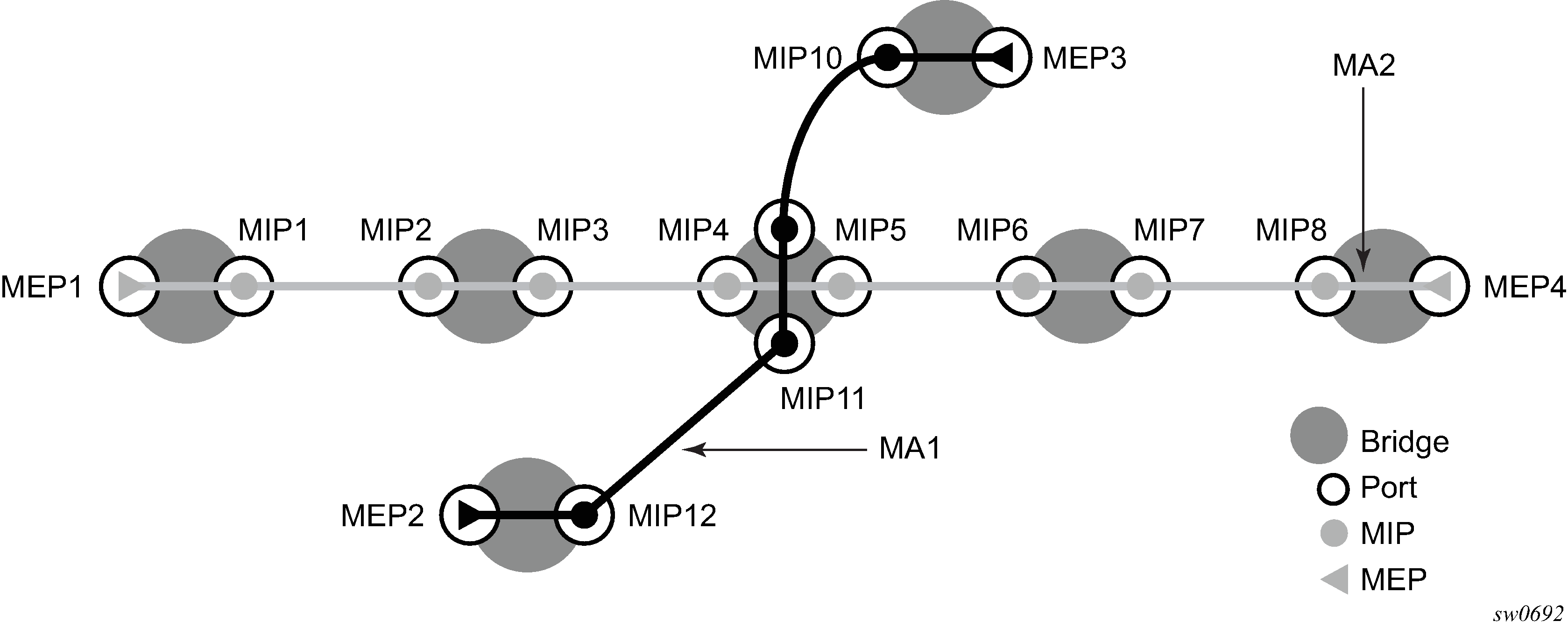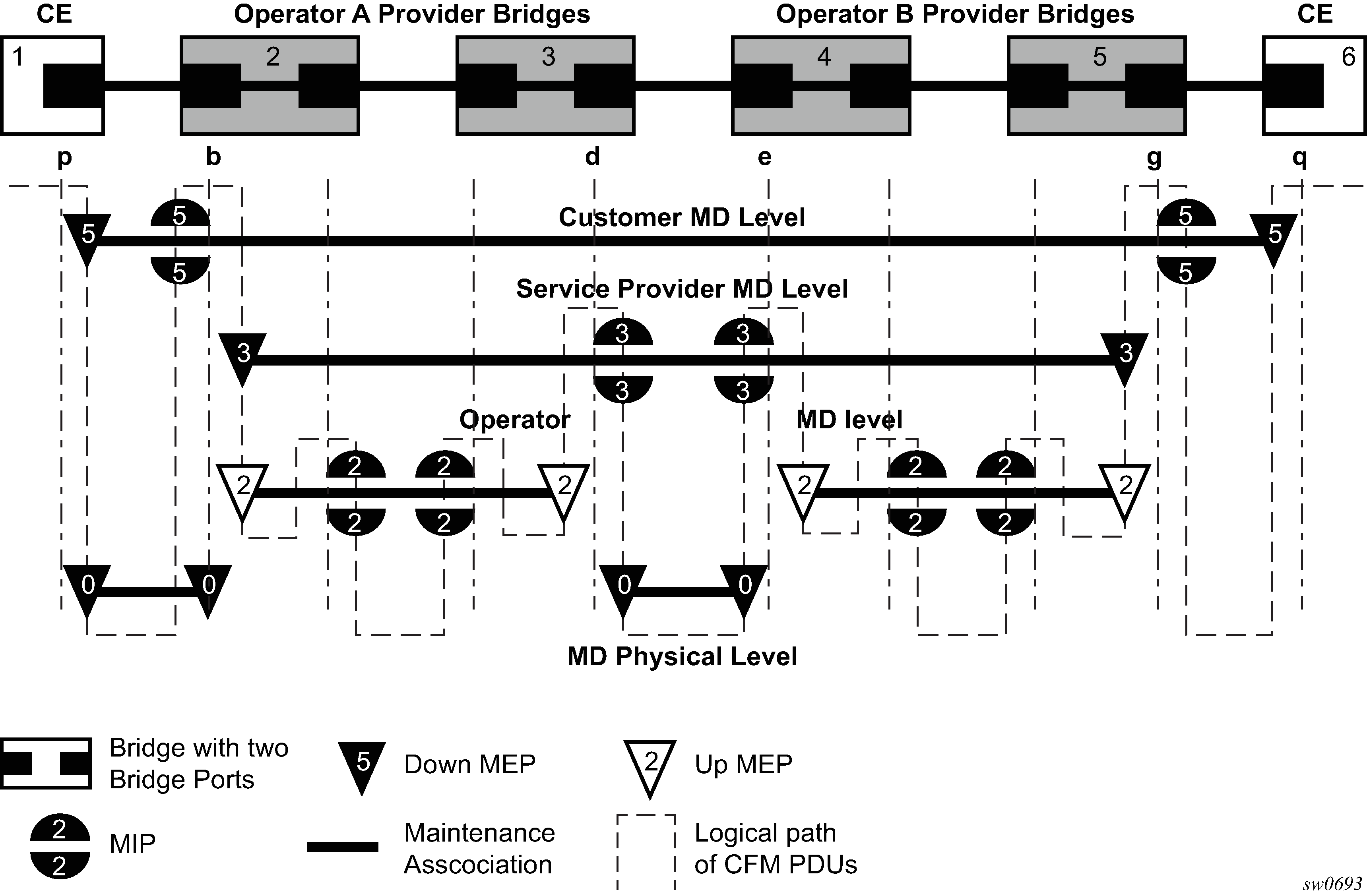The IEEE and the ITU-T use their own nomenclature when describing administrative contexts and functions. This introduces a level of complexity to configuration, description and different vendors naming conventions. The 7210 SAS OS CLI has chosen to standardize on the IEEE 802.1ag naming where overlap exists. ITU-T naming is used when no equivalent is available in the IEEE standard. In the following definitions, both the IEEE name and ITU-T names are provided for completeness, using the format IEEE Name/ITU-T Name.
Maintenance Domain (MD)/Maintenance Entity (ME) is the administrative container that defines the scope, reach and boundary for faults. It is typically the area of ownership and management responsibility. The IEEE allows for various formats to name the domain, allowing up to 45 characters, depending on the format selected. ITU-T supports only a format of none and does not accept the IEEE naming conventions:
0
Undefined and reserved by the IEEE.
1
No domain name. It is the only format supported by Y.1731 as the ITU-T specification does not use the domain name. This is supported in the IEEE 802.1ag standard but not in currently implemented for 802.1ag defined contexts.
2,3,4
Provides the ability to input various different textual formats, up to 45 characters. The string format (2) is the default and therefore the keyword is not shown when looking at the configuration.
Maintenance Association (MA)/Maintenance Entity Group (MEG) is the construct where the different management entities will be contained. Each MA is uniquely identified by its MA-ID. The MA-ID is comprised of the by the MD level and MA name and associated format. This is another administrative context where the linkage is made between the domain and the service using the bridging-identifier configuration option. The IEEE and the ITU-T use their own specific formats. The MA short name formats (0-255) have been divided between the IEEE (0-31, 64-255) and the ITU-T (32-63), with five currently defined (1-4, 32). Even though the different standards bodies do not have specific support for the others formats a Y.1731 context can be configured using the following IEEE format options:
1 (Primary VID) - values 0 to 4094
2 (String) - raw ASCII, excluding 0-31 decimal/0-1F hex (which are control characters) form the ASCII table
3 (2-octet integer) - 0 to 65535
4 (VPN ID) - hex value as described in RFC 2685, Virtual Private Networks Identifier
32 (icc-format) - exactly 13 characters from the ITU-T recommendation T.50
When a VID is used as the short MA name, 802.1ag will not support VLAN translation because the MA-ID must match all the MEPs. The default format for a short MA name is an integer. Integer value 0 means the MA is not attached to a VID. This is useful for VPLS services on 7210 SAS platforms because the VID is locally significant.
Maintenance Domain Level (MD Level)/Maintenance Entity Group Level (MEG Level) is the numerical value (0-7) representing the width of the domain. The wider the domain, higher the numerical value, the farther the ETH-CFM packets can travel. It is important to understand that the level establishes the processing boundary for the packets. Strict rules control the flow of ETH-CFM packets and are used to ensure correct handling, forwarding, processing and dropping of these packets. To keep it simple ETH-CFM packets with higher numerical level values will flow through MEPs on MIPs on SAPs configured with lower level values. This allows the operator to implement different areas of responsibility and nest domains within each other. Maintenance association (MA) includes a set of MEPs, each configured with the same MA-ID and MD level used verify the integrity of a single service instance.
Maintenance Endpoint (MEP)/MEG Endpoint (MEP) are the workhorses of ETH-CFM. A MEP is the unique identification within the association (0-8191). Each MEP is uniquely identified by the MA-ID, MEPID tuple. This management entity is responsible for initiating, processing and terminating ETH-CFM functions, following the nesting rules. MEPs form the boundaries which prevent the ETH-CFM packets from flowing beyond the specific scope of responsibility. A MEP has direction, up or down. Each indicates the directions packets will be generated; UP toward the switch fabric, down toward the SAP away from the fabric. Each MEP has an active and passive side. Packets that enter the active point of the MEP will be compared to the existing level and processed accordingly. Packets that enter the passive side of the MEP are passed transparently through the MEP. Each MEP contained within the same maintenance association and with the same level (MA-ID) represents points within a single service. MEP creation on a SAP is allowed only for Ethernet ports with NULL, Q-tags, Q-in-Q encapsulations. MEPs may also be created on SDP bindings.
Maintenance Intermediate Point (MIP)/MEG Intermediate Point (MIP) are management entities between the terminating MEPs along the service path. These provide insight into the service path connecting the MEPs. MIPs only respond to Loopback Messages (LBM) and Linktrace Messages (LTM). All other CFM functions are transparent to these entities. Only one MIP is allowed per SAP or SDP. The creation of the MIPs can be done when the lower level domain is created (explicit). This is controlled by the use of the mhf-creation mode within the association under the bridge-identifier. MIP creation is supported on a SAP and SDP, not including Mesh SDP bindings. By default, no MIPs are created.
There are two locations in the configuration where ETH-CFM is defined. The domains, associations (including linkage to the service id), MIP creation method, common ETH-CFM functions and remote MEPs are defined under the top level eth-cfm command. It is important to note, when Y.1731 functions are required the context under which the MEPs are configured must follow the Y.1731 specific formats (domain format of none, MA format icc-format). When these parameters have been entered, the MEP and possibly the MIP can be defined within the service under the SAP or SDP.
Table: ETH-CFM support matrix for the 7210 SAS-T (network mode), Table: ETH-CFM support matrix for the 7210 SAS-T (access-uplink mode), Table: ETH-CFM support matrix for 7210 SAS-Mxp Devices, Table: ETH-CFM support matrix for 7210 SAS-R6 and 7210 SAS-R12 devices, Table: ETH-CFM support matrix for 7210 SAS-Sx/S 1/10GE devices, and Table: ETH-CFM support matrix for 7210 SAS-Sx 10/100GE devices are general tables that indicate the ETH-CFM support for the different services and endpoints. It is not meant to indicate the services that are supported or the requirements for those services on the individual platforms.
| Service | Ethernet connection type | MEP | MIP | Primary VLAN | ||
|---|---|---|---|---|---|---|
| Down MEP | Up MEP | Ingress MIP | Egress MIP | |||
Epipe |
SAP |
✓ |
✓ |
✓ |
✓ |
✓ 1 |
SDP |
✓ |
✓ |
✓ |
✓ |
||
VPLS |
SAP |
✓ |
✓ |
✓ |
✓ 1 |
|
Spoke-SDP |
✓ |
✓ |
✓ |
|||
Mesh-SDP |
✓ |
✓ |
||||
RVPLS |
SAP |
|||||
IES |
IES IPv4 interface |
|||||
PBB Epipe |
I-SAP |
✓ |
||||
PBB VPLS |
I-SAP |
|||||
PBB B-VPLS |
B-SAP |
|||||
IES |
SAP |
|||||
VPRN |
SAP |
|||||
| Service | Ethernet connection type | MEP | MIP | Primary VLAN | ||
|---|---|---|---|---|---|---|
| Down MEP | Up MEP | Ingress MIP | Egress MIP | |||
Epipe |
SAP (Access and Access-uplink SAP) |
✓ |
✓ |
✓ |
✓ |
|
VPLS |
SAP (Access and Access-uplink SAP) |
✓ |
✓ |
✓ |
||
RVPLS |
SAP |
|||||
IES |
IES IPv4 interface |
|||||
SAP |
||||||
| Service | Ethernet connection type | MEP | MIP | Primary VLAN | ||
|---|---|---|---|---|---|---|
| Down MEP | Up MEP | Ingress MIP | Egress MIP | |||
Epipe |
SAP |
✓ |
✓ |
✓ |
✓ |
✓ 1 |
SDP |
✓ |
✓ |
✓ |
✓ |
||
VPLS |
SAP |
✓ |
✓ |
✓ |
✓ 1 |
|
Spoke-SDP |
✓ |
✓ |
✓ |
|
||
Mesh-SDP |
✓ |
✓ |
||||
RVPLS |
SAP |
|||||
IES |
IES IPv4 interface |
|||||
PBB Epipe |
I-SAP |
|||||
PBB VPLS |
I-SAP |
|||||
PBB B-VPLS |
B-SAP |
|||||
IES |
SAP |
|||||
VPRN |
SAP |
|||||
| Service | Ethernet connection type | MEP | MIP | Primary VLAN | ||
|---|---|---|---|---|---|---|
| Down MEP | Up MEP | Ingress MIP | Egress MIP | |||
Epipe |
SAP |
✓ |
✓ |
✓ |
✓ |
✓ 2 |
SDP |
✓ |
✓ |
✓ |
✓ |
||
VPLS |
SAP |
✓ |
✓ 3 |
✓ |
✓ |
✓ 4 |
Spoke-SDP |
✓ |
✓ 3 |
✓ |
|||
Mesh-SDP |
✓ 3 |
|||||
R-VPLS |
SAP |
|||||
IES |
IES IPv4 interface |
|||||
PBB Epipe |
I-SAP |
|||||
PBB VPLS |
I-SAP |
|||||
PBB B-VPLS |
B-SAP |
|||||
IES |
SAP |
|||||
VPRN |
SAP |
|||||
| Service | Ethernet connection type | MEP | MIP | Primary VLAN | ||
|---|---|---|---|---|---|---|
| Down MEP | Up MEP | Ingress MIP | Egress MIP | |||
Epipe |
SAP |
✓ |
✓ |
✓ |
✓ |
✓ 1 |
SDP |
✓ |
✓ |
✓ |
✓ |
||
VPLS |
SAP |
✓ |
✓ |
✓ |
✓ 1 |
|
Spoke-SDP |
✓ |
✓ |
✓ |
|||
Mesh-SDP |
✓ |
✓ |
||||
RVPLS |
SAP |
|||||
IES |
IES IPv4 interface |
|||||
PBB Epipe |
I-SAP |
|||||
PBB VPLS |
I-SAP |
|||||
PBB B-VPLS |
B-SAP |
|||||
IES |
SAP |
|||||
VPRN |
SAP |
|||||
| Service | Ethernet connection type | MEP | MIP | Primary VLAN | ||
|---|---|---|---|---|---|---|
| Down MEP | Up MEP | Ingress MIP | Egress MIP | |||
Epipe |
SAP |
✓ |
✓ |
✓ |
✓ |
✓ 1 |
SDP |
✓ |
✓ |
✓ |
✓ |
||
VPLS |
SAP |
✓ |
✓ |
✓ |
✓ 1 |
|
Spoke-SDP |
✓ |
✓ |
✓ |
|||
Mesh-SDP |
✓ |
✓ |
||||
RVPLS |
SAP |
|||||
IES |
IES IPv4 interface |
|||||
PBB Epipe |
I-SAP |
|||||
PBB VPLS |
I-SAP |
|||||
PBB B-VPLS |
B-SAP |
|||||
IES |
SAP |
|||||
VPRN |
SAP |
|||||
The following figures show the detailed IEEE representation of MEPs, MIPs, levels and associations, using the standards defined icons.

